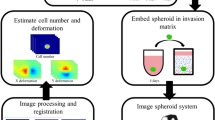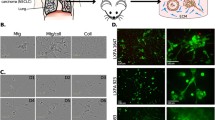Abstract
Purpose
In order to monitor the drug responses of three-dimensional mammary tumor spheroids and to elucidate the role of inter- and intra-spheroid heterogeneity in determining drug sensitivity in the spheroids, an integrated image analysis framework was developed for morphometric and metabolic characterization of the three-dimensional tumor spheroids.
Procedure
Three-dimensional spheroid cultures of primary mammary tumor epithelial cells isolated from freshly excised tumors from a transgenic mouse model of adenocarcinoma (MMTV-PyMT) were imaged by using vital dyes and mitochondrial membrane potential markers. Custom-developed java and python program codes facilitated image processing, numerical computation, and graphical analysis of large datasets generated from the experiments. A panel of cancer drugs (rapamycin, BEZ235, MK2206, and flavopiridol) was tested to determine the degree of drug sensitivity as well as heterogeneity in drug response.
Results
A new quantitative metric (growth/toxicity) was developed based on morphometric parameters that were found to track the growth and apoptotic cell populations. Further, this study identified two parameters, namely, skew and kurtosis—which report the spatial heterogeneity in mitochondrial metabolism within the spheroids. The results of this study show that three-dimensional tumor spheroids selectively respond to cancer drugs depending on the specific metabolic pathways (AKT inhibition pathway in the present study), and there exists significant heterogeneity in the untreated tumor spheroids. Drug sensitivity of the spheroids was found to be associated with significant alterations in mitochondrial heterogeneity within the spheroids.
Conclusions
In conclusion, the quantitative imaging of morphometric and metabolic analysis in large image datasets can serve as an excellent tool box for characterizing tumor heterogeneity in three-dimensional tumor spheroids and potentially, in intact tumors as well.






Similar content being viewed by others
References
Hanahan D, Weinberg RA (2011) Hallmarks of cancer: the next generation. Cell 144:646–674
Tennant DA, Duran RV, Boulahbel H, Gottlieb E (2009) Metabolic transformation in cancer. Carcinogenesis 30:1269–1280
Narod S (2016) Breast cancer: the importance of overdiagnosis in breast-cancer screening. Nat Rev Clin Oncol 13:5–6
Martelotto LG, Ng CK, Piscuoglio S et al (2014) Breast cancer intra-tumor heterogeneity. Breast Cancer Res 16:210
Potts SJ, Krueger JS, Landis ND, Eberhard DA, David Young G, Schmechel SC, Lange H (2012) Evaluating tumor heterogeneity in immunohistochemistry-stained breast cancer tissue. Lab Investig 92:1342–1357
Sengupta D, Pratx G (2016) Imaging metabolic heterogeneity in cancer. Mol Cancer 15:4
Kim JB, O'Hare MJ, Stein R (2004) Models of breast cancer: is merging human and animal models the future? Breast Cancer Res 6:22–30
Hu Z, Fan C, Oh DS, Marron JS, He X, Qaqish BF, Livasy C, Carey LA, Reynolds E, Dressler L, Nobel A, Parker J, Ewend MG, Sawyer LR, Wu J, Liu Y, Nanda R, Tretiakova M, Orrico A, Dreher D, Palazzo JP, Perreard L, Nelson E, Mone M, Hansen H, Mullins M, Quackenbush JF, Ellis MJ, Olopade OI, Bernard PS, Perou CM (2006) The molecular portraits of breast tumors are conserved across microarray platforms. BMC Genomics 7:96
Elsasser WM (1984) Outline of a theory of cellular heterogeneity. Proc Natl Acad Sci U S A 81:5126–5129
Ma Z, Shiao SL, Yoshida EJ, Swartwood S, Huang F, Doche ME, Chung AP, Knudsen BS, Gertych A (2017) Data integration from pathology slides for quantitative imaging of multiple cell types within the tumor immune cell infiltrate. Diagn Pathol 12:69
Simian M, Bissell MJ (2017) Organoids: a historical perspective of thinking in three dimensions. J Cell Biol 216:31–40
Friedrich J, Seidel C, Ebner R, Kunz-Schughart LA (2009) Spheroid-based drug screen: considerations and practical approach. Nat Protoc 4:309–324
Lin EY, Jones JG, Li P, Zhu L, Whitney KD, Muller WJ, Pollard JW (2003) Progression to malignancy in the polyoma middle T oncoprotein mouse breast cancer model provides a reliable model for human diseases. Am J Pathol 163:2113–2126
Ramanujan VK (2019) Rapid assessment of mitochondrial complex I activity and metabolic phenotyping of breast cancer cells by NAD(p)H cytometry. Cytometry Part A 95:101–109
Ramanujan VK (2014) Metabolic imaging in multiple time scales. Methods 66:222–229
Najafi M, Soltanian-Zadeh H, Jafari-Khouzani K, Scarpace L, Mikkelsen T (2012) Prediction of Glioblastoma Multiform Response to Bevacizumab Treatment Using Multi-Parametric MRI. PLoS One 7:e29945
Stottrup C, Tsang T, Chin YR (2016) Upregulation of AKT3 confers resistance to the AKT inhibitor MK2206 in breast Cancer. Mol Cancer Ther 15:1964–1974
Wang H, Huang F, Wang J, Wang P, Lv W, Hong L, Li S, Zhou J (2015) The synergistic inhibition of breast cancer proliferation by combined treatment with 4EGI-1 and MK2206. Cell Cycle 14:232–242
Tan AR, Swain SM (2002) Review of flavopiridol, a cyclin-dependent kinase inhibitor, as breast cancer therapy. Semin Oncol 29:77–85
Tong CWS, Wu M, Cho WCS, To KKW (2018) Recent advances in the treatment of breast Cancer. Front Oncol 8:227
Kalinsky K, Sparano JA, Zhong X, Andreopoulou E, Taback B, Wiechmann L, Feldman SM, Ananthakrishnan P, Ahmad A, Cremers S, Sireci AN, Cross JR, Marks DK, Mundi P, Connolly E, Crew KD, Maurer MA, Hibshoosh H, Lee S, Hershman DL (2018) Pre-surgical trial of the AKT inhibitor MK-2206 in patients with operable invasive breast cancer: a New York Cancer consortium trial. In: Clin Transl Oncol, vol 20, pp 1474–1483
Blagosklonny MV (2004) Flavopiridol, an inhibitor of transcription: implications, problems and solutions. Cell Cycle 3:1537–1542
Mukherjee B, Tomimatsu N, Amancherla K, Camacho CV, Pichamoorthy N, Burma S (2012) The dual PI3K/mTOR inhibitor NVP-BEZ235 is a potent inhibitor of ATM- and DNA-PKCs-mediated DNA damage responses. Neoplasia 14:34–43
Trilla-Fuertes L, Gamez-Pozo A, Arevalillo JM et al (2018) Molecular characterization of breast cancer cell response to metabolic drugs. Oncotarget 9:9645–9660
Xu HN, Zheng G, Tchou J, Nioka S, Li LZ (2013) Characterizing the metabolic heterogeneity in human breast cancer xenografts by 3D high resolution fluorescence imaging. Springerplus 2:73
Bellance N, Lestienne P, Rossignol R (2009) Mitochondria: from bioenergetics to the metabolic regulation of carcinogenesis. Front Biosci 14:4015–4034
Kroemer G (2006) Mitochondria in cancer. Oncogene 25:4630–4632
Collins TJ, Bootman MD (2003) Mitochondria are morphologically heterogeneous within cells. J Exp Biol 206:1993–2000
Ye XQ, Wang GH, Huang GJ, Bian XW, Qian GS, Yu SC (2011) Heterogeneity of mitochondrial membrane potential: a novel tool to isolate and identify cancer stem cells from a tumor mass? Stem Cell Rev 7:153–160
Kuznetsov AV, Margreiter R (2009) Heterogeneity of mitochondria and mitochondrial function within cells as another level of mitochondrial complexity. Int J Mol Sci 10:1911–1929
Rohwer N, Cramer T (2011) Hypoxia-mediated drug resistance: novel insights on the functional interaction of HIFs and cell death pathways. Drug Resist Updat 14:191–201
Orme ME, Chaplain MA (1996) A mathematical model of the first steps of tumour-related angiogenesis: capillary sprout formation and secondary branching. IMA J Math Appl Med Biol 13:73–98
Chaplain MA, Anderson AR (1996) Mathematical modelling, simulation and prediction of tumour-induced angiogenesis. Invasion Metastasis 16:222–234
Acknowledgements
The author gratefully acknowledges Bruce Gewertz, MD, for his continuous support and inspiration.
Funding
Financial support was provided by American Cancer Society (RSG-12-144-01-CCE), National Cancer Institute/National Institutes of Health (R21-CA124843), Komen for the Cure Foundation (KG090239), and Donna & Jesse Garber Foundation.
Author information
Authors and Affiliations
Corresponding author
Ethics declarations
Conflict of Interest
The author declares that he has no conflict of interest.
Additional information
Publisher’s Note
Springer Nature remains neutral with regard to jurisdictional claims in published maps and institutional affiliations.
Electronic Supplementary Material
ESM 1
(PDF 888 kb)
Rights and permissions
About this article
Cite this article
Ramanujan, V.K. Quantitative Imaging of Morphometric and Metabolic Signatures Reveals Heterogeneity in Drug Response of Three-Dimensional Mammary Tumor Spheroids. Mol Imaging Biol 21, 436–446 (2019). https://doi.org/10.1007/s11307-019-01324-7
Published:
Issue Date:
DOI: https://doi.org/10.1007/s11307-019-01324-7




